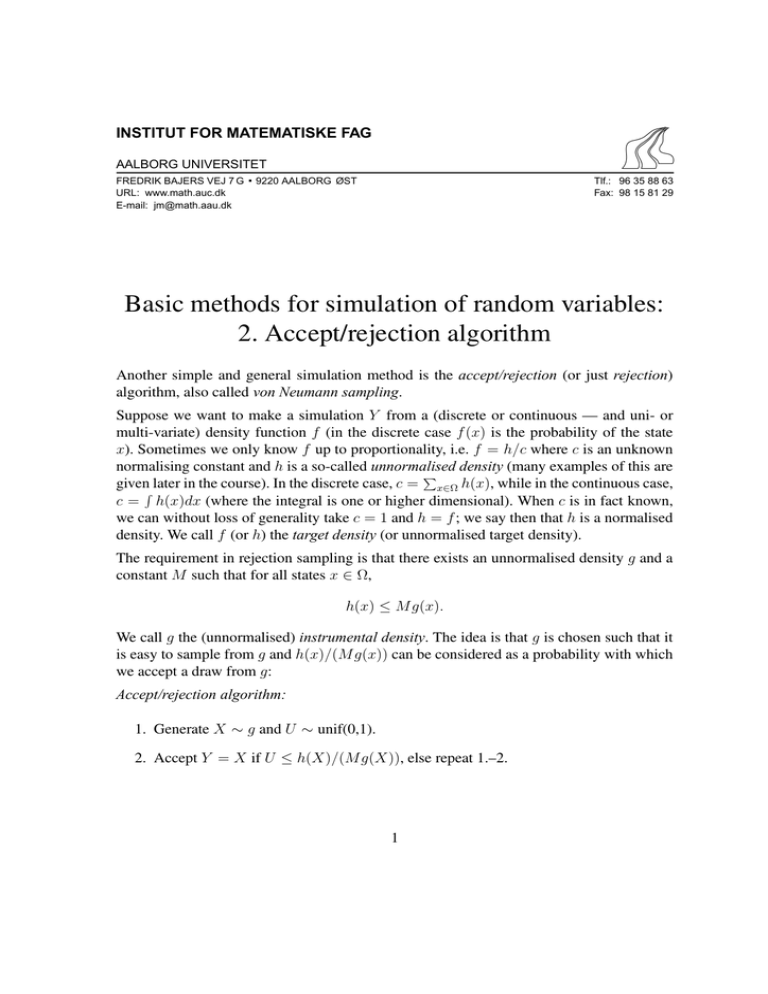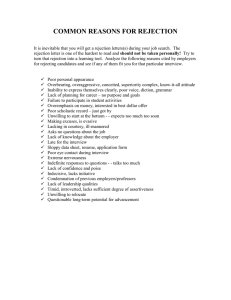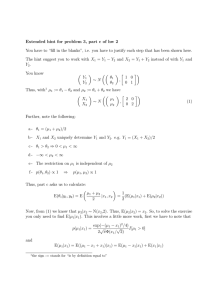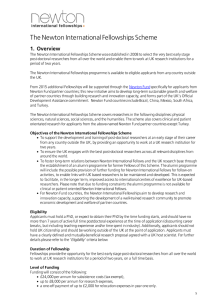2. Accept/rejection algorithm
advertisement

INSTITUT FOR MATEMATISKE FAG
AALBORG UNIVERSITET
FREDRIK BAJERS VEJ 7 G
URL: www.math.auc.dk
E-mail: jm@math.aau.dk
9220 AALBORG ØST
Tlf.: 96 35 88 63
Fax: 98 15 81 29
Basic methods for simulation of random variables:
2. Accept/rejection algorithm
Another simple and general simulation method is the accept/rejection (or just rejection)
algorithm, also called von Neumann sampling.
Suppose we want to make a simulation Y from a (discrete or continuous — and uni- or
multi-variate) density function f (in the discrete case f (x) is the probability of the state
x). Sometimes we only know f up to proportionality, i.e. f = h/c where c is an unknown
normalising constant and h is a so-called unnormalised density (many examples of this are
P
givenR later in the course). In the discrete case, c = x∈Ω h(x), while in the continuous case,
c = h(x)dx (where the integral is one or higher dimensional). When c is in fact known,
we can without loss of generality take c = 1 and h = f ; we say then that h is a normalised
density. We call f (or h) the target density (or unnormalised target density).
The requirement in rejection sampling is that there exists an unnormalised density g and a
constant M such that for all states x ∈ Ω,
h(x) ≤ M g(x).
We call g the (unnormalised) instrumental density. The idea is that g is chosen such that it
is easy to sample from g and h(x)/(M g(x)) can be considered as a probability with which
we accept a draw from g:
Accept/rejection algorithm:
1. Generate X ∼ g and U ∼ unif(0,1).
2. Accept Y = X if U ≤ h(X)/(M g(X)), else repeat 1.–2.
1
Exercise 1
1. Show that the accept/rejection algorithm produces a variable Y distributed according
to f .
Hint:
!
h(X)
.
P (Y ∈ F ) = P X ∈ F U ≤
M g(X)
2. Suppose that both h and g are normalised densities.
(a) Show that M ≥ 1 and the probability of acceptance in step 2. of the accept/rejection algorithm is given by p = 1/M .
(b) Let N denote the number of trials before acceptance in step 2. Show that
P (N = n) = p(1 − p)n ,
n = 0, 1, . . .
(this distribution is called the geometric distribution).
(c) Show that the mean number of times we perform steps 1.–2. is given by
E(N + 1) = M.
Hint: Recall that for any number q ∈ (−1, 1) we have that
∞
X
qn =
n=0
and so
∞
d X
d
d n
q =
qn =
dq n=1
dq
n=1 dq
∞
X
1
1−q
!
1
1
−1 =
.
1−q
(1 − q)2
3. Discuss what would be good and bad choices of instrumental densities.
Exercise 2
Suppose h(x) = exp(−x2 /2) is our unnormalised target density (you probably recognise
this density as that of a standard normal distribution N (0, 1)). Consider the unnormalised
instrumental density
g(x) = exp(−|x|),
1. Show that h(x)/g(x) ≤
√
−∞ < x < ∞.
e and E(N + 1) =
2
q
2e/π = 1.315 (see Exercise 1).
2. How would you simulate from the instrumental density?
Hint: Show that we can take X = W Z, where Z is exponentially distributed with
parameter 1 (i.e. P (Z > z) = exp(−z) for z ≥ 0), and W is a uniform random
variable on {−1, 1} (i.e. P (W = −1) = P (W = 1) = 1/2).
3. Implement the accept/rejection algorithm in R so that simulations from N (0, 1) of
length n = 1000 are produced and E(N + 1) is estimated by its empirical mean.
Exercise 3
The beta distribution with parameters α > 0 and β > 0 has a continuous density given by
f (x) =
1
xα−1 (1 − x)β−1 ,
B(α, β)
0 < x < 1,
where
B(α, β) = Γ(α)Γ(β)/Γ(α + β) is the so-called complete beta function and Γ(α) =
R ∞ α−1
y
exp(−y)dy is the so-called gamma function.
0
1. Make plots in R of the target density f when (α, β) = (0.5, 0.5), (1, 0.5), (0.5, 1),
(1, 1), (1, 2), (2, 1), (2, 2), (5, 10).
Hint: gamma is the gamma function in R.
2. In this and the following questions we let α > 1 and β > 1. Show that f (x) is
increasing for x ≤ (α − 1)/(α + β − 2) and decreasing for x ≥ (α − 1)/(α + β − 2).
3. Discuss how you would chooce an instrumental density.
4. Find E(N + 1) (see Exercise 1) when g(x) = 1 for 0 ≤ x ≤ 1 and (α, β) =
(2, 2), (5, 10).
Hint: Γ(α) = (α − 1)! when α ≥ 1 is an integer.
5. Implement the accept/rejection algorithm in R. Compare with results produced by
the R-function rbeta.
3



